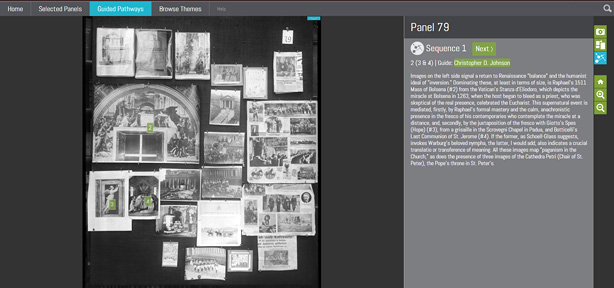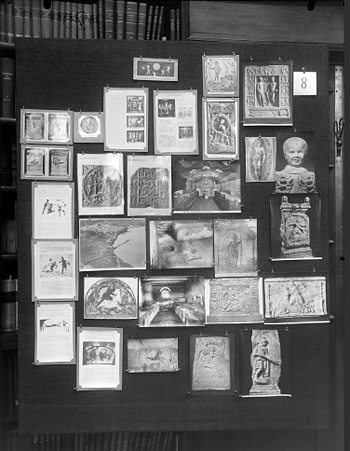
Screenshot from the website http://warburg.library.cornell.edu, where users can navigate the collaged images of Aby Warburg's celebrated "Mnemosyne Atlas."
New library website brings Warburg atlas to unexpected audiences
Online tools make new experiences possible -- like the experience of accompanying a brilliant thinker on fragmentary meanderings through art and culture.

German "cultural scientist" Aby Warburg was one of the founders of iconography in early 20th-century art history. Image: Wikimedia Commons.
Through a website developed as part of the 2012 Arts and Sciences Digitization Grants program, users can navigate the collaged images of Aby Warburg's celebrated "Mnemosyne Atlas," a metaphoric encyclopedia that created visual constellations meant to spark memory and imagination.
German "cultural scientist" Aby Warburg, one of the founders of iconography in early 20th-century art history, assembled the images on huge wooden panels, in part as a way of storyboarding the atlas that he never completed in book form. Warburg died in 1929, with the project still in progress.
When the Nazis rose to power four years later, Warburg's extensive library and the research institute in cultural history that he had built around it found refuge in London. The 63 panels of the atlas survived only in photographs, which are preserved in the archives of the Warburg Institute of the University of London, Cornell's partner on the new website.
It re-creates 10 of those panels, making high-quality digital scans available for the first time online and providing new guides through Warburg's eerie masterwork.
No other tool quite like this exists in the digital humanities, according to Danielle Mericle, director of Cornell University Library's Digital Media Group, which created the site. She said it's the most innovative project that has come from the digitization grants, which are a long-standing collaboration between the library and the College of Arts and Sciences.
"The whole project really pushed the envelope of all our abilities," she says. "We opened up pathways through these panels, so that you can zoom in and out of the images and in and out of different subjects and ideas. It's a tool that changes the way you can understand the subject."

Detail of the Mnemosyne Atlas, Panel 8, "Ascent to the Sun," which connects heliotropism, a cult in 4th-century Rome and the Pueblo Indians of the Southwest. Image: Cornell University Library.
The project, which also received funding from The Andrew W. Mellon Foundation, offers a new way of looking at scholarship and publishing in the humanities. It began with a book published in a series, "Signale: Modern German Letters, Cultures, and Thought," co-sponsored by Cornell University Library and Cornell University Press (CUP). "Memory, Metaphor, and Aby Warburg's Atlas of Images" was written by Christopher D. Johnson, now a visiting professor in the Department of Spanish and Portuguese at the University of California, Los Angeles. Like all Signale books, it is published in print and as an e-book.
The Warburg site takes the book a step further, said Peter Potter, CUP editor in chief.
"It's really a wonderful example of how a scholarly publisher can develop digital products that complement but don't necessarily replace the physical book," he says. The press also publishes e-books, but "this is a more experiential approach to the material. If you come to the website, you'll have a better understanding of the book, and vice versa."
Cornell's relationship with Warburg runs deep; the university hosted a symposium on his work in the mid-1990s. And for the Warburg atlas site, a diverse array of people inside and outside the university came together. Peter Hohendahl, Signale's editor, and Kizer Walker, Signale's managing editor and the library's director of collection development, were the lead sponsors.
"There's a long-standing, interdisciplinary interest in Warburg at Cornell, and that's partly what sparked our interest in the book in the first place," Walker notes.
Warburg's brilliance was evident in the way he made unexpected associations across time and space, Walker says. "With the website, we wanted to allow visitors to follow Warburg's associations and to make their own. Because the atlas was left unfinished, it's extraordinarily open to interpretation. We are also providing interpretive 'pathways' that walk the user through the panels. The author of the book created the first pathway, and we're recruiting Warburg scholars from various places to do more, as well."
There is much on the site that will aid scholarship, including an extensive bibliography. But it isn't just for Warburg scholars, Walker says. "In fact, you don't have to have any familiarity with Warburg to explore the site and still have a great experience with it."
So, are visual, interactive, online experiences part of the future of scholarly publishing?
Yes, according to Potter.
"Books will still be with us," he notes, but "at the same time, there are things you can do in new media that you can't do in print. We're going to increasingly see digital products that don't duplicate but complement other scholarship in print form."
Gwen Glazer is the staff writer/editor for Cornell University Library.
Related links:
Mnemosyne: Meanderings through Aby Warburg's Atlas
Cornell Chronicle: Grants will digitize Obama memorabilia, early maps
Signale: Modern German Letters, Cultures and Thought